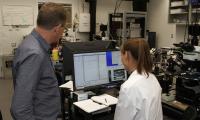She sat at the winners’ table – and she doesn’t regret it

A Brain Prize meeting ended up having a major impact on 29-year-old molecular biologist Camilla Lundbye. She subsequently received a Lundbeck Foundation scholarship and is now taking a PhD at the University of Toronto in Canada, with one of the world’s most prestigious brain researchers as her supervisor.
If you want to dance, you need to be willing to venture onto the dance floor and join in. Recognising this, Camilla Lundbye took a deep breath one November evening in 2016. She was at Hindsgavl Castle, just outside the Danish town of Middelfart, at the Lundbeck Foundation’s annual brain research seminar. The keynote speakers are always the year’s winners of The Brain Prize, the world’s largest brain research prize, and she took a seat at the winners’ table.
A number of particularly talented young brain researchers always take part in the seminar. It gives them the opportunity to meet older and more experienced colleagues and to talk about their own research, or the research they dream of conducting.
Consequently, the seminar acts as a kind of scientific marketplace. Contacts are fostered, ideas are exchanged and collaboration is established. The programme also includes a good – and intentionally informal – dinner. Camilla Lundbye remembers that, before it began, participants had to find their own seats:
‘At the time, I was just finishing my masters in molecular biology, and I think I only knew a handful of the participants at Hindsgavl – my supervisor, a professor and a couple of other students from Aarhus University, where I’d studied. Of course, I could have joined my fellow students at their table, but I said yes when my supervisor asked if I’d like to sit with him and Professor Graham Collingridge, one of the year’s Brain Prize winners, and some other professors.’
‘I’ll sit there, too, I thought – even though I’d be the only student at the table and would have to step out of my comfort zone. I knew Professor Collingridge was one of the best in the world in the field of synaptic plasticity, and that’s the field I worked in at university. So, I very much wanted to get to know him. This was a unique opportunity, so I mustered up courage and sat down at their table. I’ve no regrets.’

Onwards to Toronto
Camilla Lundbye and Graham Collingridge soon began chatting about synaptic plasticity; about the almost unimaginably complicated network of communication channels – synapses – which criss-cross and connect the approximately 100 billion neurons that make our brains work, enabling us to act, remember, learn, think and reason.
Synapses are in no way a static ‘bundle of wires’. On the contrary, they are versatile – plastic – and can form new communication channels between the neurons in the brain and centres we have not previously investigated, for example centres we use when we solve tasks. Synaptic plasticity plays a key role in, for instance, learning and memory.
‘In the course of my conversation with Professor Collingridge, I explained what my research is about, and we came up with the idea for me to take my PhD at the University of Toronto in Canada where Professor Collingridge had recently established his own neuroscience research group. He offered to be my supervisor, and things actually went pretty fast from there,’ Camilla, 29, explains:
‘I applied and received a PhD scholarship from the Lundbeck Foundation, and in August 2017 my husband – Mads – and I arrived in Toronto. I’ve been conducting research in Graham Collingridge’s lab ever since. With one break, because I’ve also been on maternity leave. Our daughter, who’s almost a year old now, was born over here.’
The family lives in the centre of Toronto. This is practical in terms of transport and it gives them plenty of opportunity to enjoy the many attractions the city has to offer. Camilla Lundbye says:
‘We could have lived in a residential area in a Toronto suburb. We did consider it, but living in the centre of the city makes daily life easier for our little family and makes it easier to see the friends we’ve made here.’
A move from Denmark to Canada may seem complicated, but Camilla explains that, to a certain extent, she and Mads took it one step at a time:
‘Before I began working at the University of Toronto – actually before I’d even accepted Professor Collingridge’s offer – we came over to take a good look at the housing market. And then, of course, there was the question of what Mads would do. At the time, he worked for Randers Municipality, but he resigned and was lucky enough to get a job as commercial advisor at the Danish Consulate General in Toronto. All of a sudden, lots of things just clicked into place.’
Mouse brains
Around 30 brain researchers from all over the world work at Graham Collingridge’s lab at the University of Toronto, and new researchers regularly join the team.
‘It really is an international environment, and everyone understands how important it is to be able to combine career and family life – and there’s always someone at hand if you need help or inspiration for research-related issues. In Canada, the normal duration of a PhD programme is four to five years, and every six months you have to attend a committee consultation to present your results – and to explain how you’re planning your future research activities. Ultimately, the committee decides whether you’ll be allowed to complete your PhD. On the other hand, the committee, which is made up of researchers who are experts in the field in question, also gives good advice and constructive criticism. I think the system works well,’ says Camilla Lyndbye.
Camilla develops mouse models aimed at mapping the effect of three genetic mutations in relation to developmental disorders on the autism spectrum. The hypothesis is that the three genes sabotage synaptic activity in different ways and may be the cause of some of the serious cognitive and social problems characteristic of autism spectrum disorders.
For obvious ethical reasons, as is the case with so many other brain research projects, we must seek to elucidate diseases in humans by conducting trials on animals. Camilla explains that mice are well suited for the purpose. She herself uses mice which have had the three mutations encoded in their DNA by means of genetic engineering.
The trial, which meets all animal welfare principles, involves killing the mouse and removing its brain. Camilla Lundbye explains:
‘It needs to go fast. We then place the brain in a solution of salts and sugar – similar to brain fluid – and cool it down. This keeps it alive.’
The next step for Camilla is to cut the mouse brain into 0.4 mm slices, using what can best be described as a tiny, razor-sharp meat slicer. She then subjects the slices to a variety of measurements and she tries to prove whether and how the three defective genes affect synaptic activity.
‘And then we hope that, in the long term, the knowledge we gain will enable us to design personalised drugs to improve the level of function and well-being of people born with an autism gene defect,’ says Camilla Lundbye.
Tips for studying abroad
Camilla Lundbye is happy to explain how she and her family planned and organised their Toronto stay. You are welcome to contact Camilla at this email address: camillajlundbye@hotmail.com
Young scientists wishing to enhance their qualifications by working abroad can apply for funding in the form of a Lundbeck Foundation postdoc scholarship.
The Lundbeck Foundation grants a number of postdoc scholarships each year. These scholarships cover two to three years of study abroad.
A postdoc scholarship is worth approximately DKK 800,000 per year. A one-off travel allowance of up to DKK 75,000 may also be granted, and in some cases a maintenance allowance of up to DKK 50,000.


